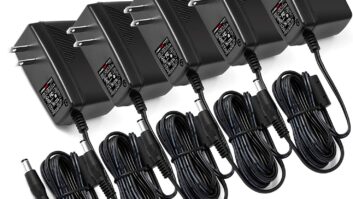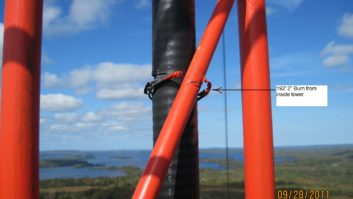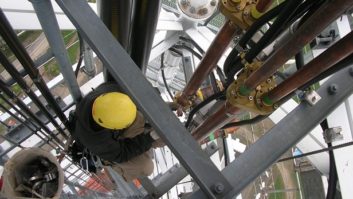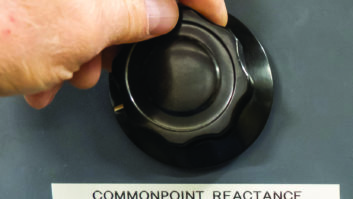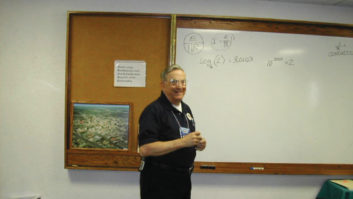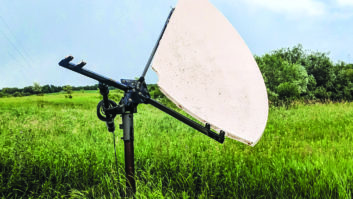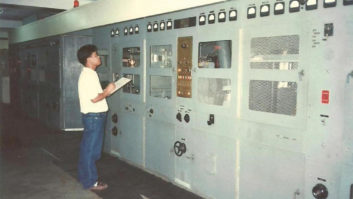It is easy to do the minimum on a job. You’ve seen it happen, and so have I. Sloppy work degrades an installation and can be an eyesore. Ultimately, it can become a “house of cards” that collapses upon itself. Why should anyone settle for that?
I make a conscious effort to do clean work, even if previous work was done poorly in that location. In essence, I kicked it up a notch. You should, too. It’s better to take a little extra time to do it right the first time than have to face the consequences of a bad installation later.

Fig. 1: A nice clean cable ends with tinned stranded wires.

Fig. 2: Two shielded pair cables tied together.
TAKE PRIDE IN YOUR WORK
Fig. 1 illustrates a method of doing clean installations. Two shielded pair audio cables are prepared for termination. The otherwise bare shield drain wire is covered by clear heat shrink tubing. Likewise, the foil shield end of the cable is protected from touching something it shouldn’t by black heat shrink tubing. It takes less than a minute to do the job and is worth it because it prevents problems.
Fig. 2 shows two shielded pair cables that have been twisted together to form a stereo pair. Yes, I know there are stereo cables that come from factories bonded together. The point here is that heat shrink tubing is used to keep the cables from being separated from each other. This kind of organization is the right thing to do to avoid confusion later.
RACK GROUNDING
Sometimes broadcast equipment winds up in a wooden rack. In that case, the equipment needs to be grounded more than ever.

Fig. 3: Good grounding in a wooden rack.
Fig. 3 shows such an arrangement, in which copper braid is run vertically on a cabinet member, then short jumpers are screwed to the braid and to each piece of equipment. The braid was the shield, pulled from a piece of RG-8 cable. The jumpers are two-pair audio shielded cable with all conductors bared and crimped into a terminal at each end. These are larger than normal size wire terminals because they have to handle five wires at a time. The jumpers are short with rounded corners, not square, to make it easy for lightning to follow to ground. The best practice is for jumpers to have an insulating jacket so they don’t cause a problem when accidentally touched to something else in the rack.
On that same point, bonding wires between equipment and a rack are still proper even when the rack is metal. Paint on the rack can, in some cases, insulate the rack from equipment. The best choice is to run a one inch or larger copper strap on the inside of a rack, top to bottom, bolted to one side. Make sure that strap goes to station ground — you’ll be very embarrassed if there is lightning damage, if you haven’t connected it.
[More Tech Tips: “Yes You Can Build Your Own”]

Fig. 4: A custom wood equipment rack.

Fig. 5: The back of the rack seen in Fig. 4.
Fig. 4 shows a three-bay equipment rack system that was constructed on site with a minimum of expense. The area started out as a closet, which was accessed from the other side. The wall was partially dismantled and reconfigured with metal rack rails. Middle-Atlantic Products makes model RRF-45, 78-3/4 inches, just for this purpose.
Smaller rails are available too. The rails are L shaped to screw to the wood sides. They have a series of drilled and tapped 10-32 holes where 19-inch equipment can be bolted in. (Measure twice and cut once when doing this.)
The station had a carpenter install three 2×6 studs, side by side, at each dividing point between rack bays. The carpenter left an additional 3/16 inch between the sides to make up for errors. Rack rails were then screwed to the wood with small flat washers to get the spacing exactly right. Fig. 5 shows the closet door open so the equipment can be worked on from the back side.
There are plastic cable clamps used for routing cables and outlet strips to plug the equipment into between the rack bays. Yes, there are grounding conductors running behind the wiring too. The photo was taken after a few years of use, so the wiring is not as neat as I would normally like to see.
STL PROBLEM
This is an interesting and true tale of hum and buzz in a 950 MHz STL system.

Fig. 6: An STL preamplifier with a problem.

Fig. 7: An oscilloscope reveals the answer.
At first, it was assumed that there were bad electrolytic capacitors in the STL transmitter or receiver. Replacing the pair resulted in the same problem. Further examination revealed that an external 950 MHz RF preamplifier, at the receive end of the system, was the cause. How could that be?
Fig. 6 shows the preamp was powered by a 12 VDC wall-wart that has an electrolytic capacitor inside to smooth out DC. The capacitor failed by opening up, resulting in DC with a high component of AC ripple feeding the preamplifier. Fig. 7 shows what the supply voltage looked like on an oscilloscope. Ouch! The preamplifier, in essence, turned on and off at a 120 Hz rate, thus the buzz in an already weak FM STL signal.
SITE CLEANING
You’ve seen it before, a transmitter site that is overgrown by brush. There is at least one good tower contractor in Minnesota who brings a “brush hog” to sites when doing inspections. The operator clears a path from the tower to each guy point and then around each point to facilitate maintenance.

Fig. 8: “A brush hog” works to clean up transmitter site grounds.
Fig. 8 shows a brush hog clearing around the transmitter building too. Nicely done. Hogs have large tires that are unlikely to damage an AM ground system. Best to stay away from in front of a machine as it might throw a rock in your direction.
AM ground system damage can be repaired easily — if discovered when it happens.
The normal specification for an AM ground system is 120 #10 bare copper radials going out for about 1/4 wavelength like equally spaced spokes of a wheel. The usual practice is to bury them 4 to 6 inches below the ground surface.
When a copper ground wire is cut, just grab the ends and pull them up so 6 inches or more is showing. Mark them and come back with a 12-inch or longer piece of #10 bare copper wire. Twist the ends together and then braze with an oxygen and acetylene torch. You can use a Mapp gas torch, but they don’t get as hot.

Fig. 9: A tower worker climbing almost to the moon.
For brazing rods, I use Sta-Silv 15, which contains 15 percent silver. You don’t use a lot, so the cost is not that steep. Do not use ordinary tin/lead solder. It will deteriorate underground and fail.
Fig. 9 shows a tower worker with blue skies and the early morning moon nearby. If you work indoors, you miss some of the great scenery that engineers often witness.
Use your head to do the job right the first time. It makes perfect sense.
Comment on this or any article. Write to[email protected].
Mark Persons, WØMH, is a Certified Professional Broadcast Engineer and has more than 40 years’ experience. His website iswww.mwpersons.com.





